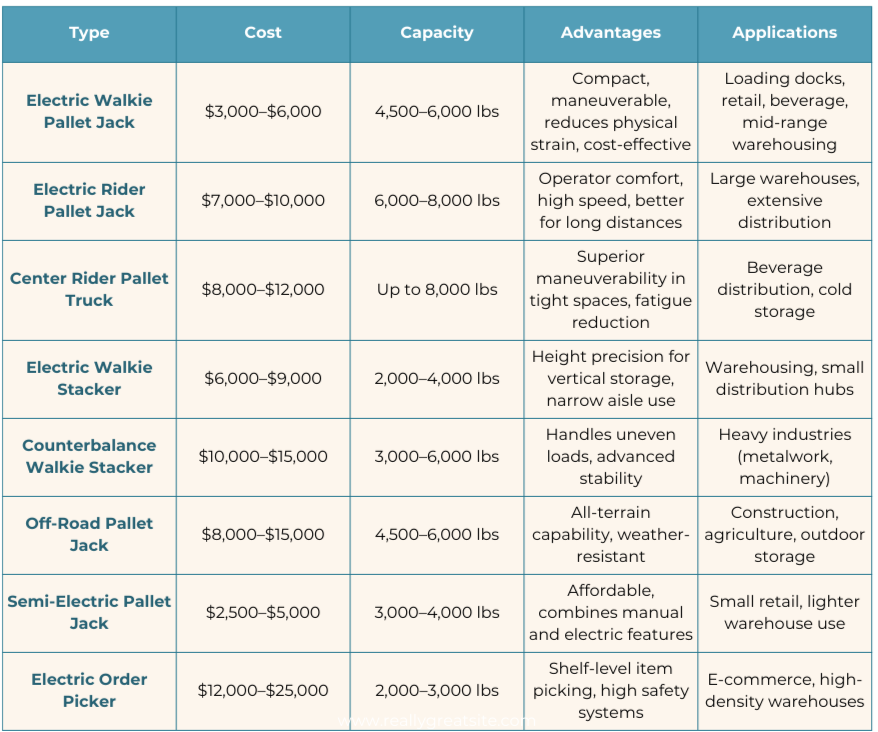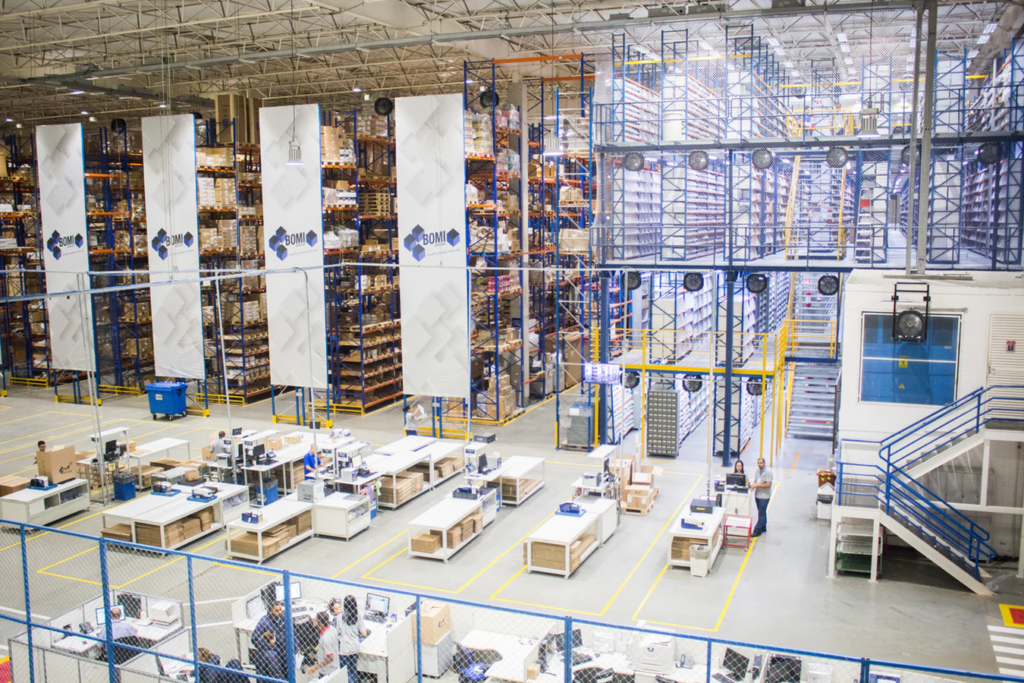Electric pallet jacks aren’t just equipment—they’re the unsung heroes of modern logistics and warehousing.
Let me take you back to my early days in warehouse management. I remember walking into a massive distribution center, overwhelmed by the symphony of machinery humming around me. That was the moment I realized these machines are more than just tools—they’re the circulatory system of industrial operations.
Key Takeaways

Electric Walkie Pallet Jack
The Electric Walkie Pallet Jack epitomizes efficiency in material handling, transforming traditional manual pallet movement into a streamlined, powered operation. These compact yet powerful machines are the workhorses of modern warehouses, distribution centers, and retail environments. Unlike their manual counterparts, electric walkie pallet jacks eliminate the physical strain of pushing and pulling heavy loads, revolutionizing workplace ergonomics.
Distinctive characteristics include:
- Powered electric drive and lift systems
- Compact design allowing navigation through narrow aisles
- Reduced operator fatigue through electric assistance
- Ideal for short to medium-distance material transportation
- Versatile applications across multiple industries
Electric Rider Pallet Jack
The Electric Rider Pallet Jack represents the next evolution in material handling equipment, offering operators a seated position for extended operational periods. This design is particularly valuable in large warehouses, distribution centers, and facilities requiring extensive material movement across significant distances.
Unique advantages include:
- Operator comfort through seated riding position
- Enhanced productivity for long-haul material transportation
- Greater load capacity compared to walk-behind models
- Improved operator visibility and control
- Reduced physical strain during extended operations
Center Rider Electric Pallet Truck
The Center Rider Electric Pallet Truck represents a pinnacle of ergonomic design in warehouse logistics. Unlike traditional pallet trucks, this model features a centralized operator platform that enables unprecedented maneuverability and operational efficiency. The operator stands at the truck’s center, providing enhanced visibility and control, which is particularly advantageous in tight spaces like cold storage facilities, beverage distribution centers, and manufacturing environments.
Key advantages include:
- Minimal operator fatigue due to optimized standing position
- Enhanced maneuverability in confined spaces
- Rapid load transfer capabilities
- Ideal for high-volume material handling operations
Electric Walkie Pallet Stacker
An evolution beyond traditional manual pallet handling, the Electric Walkie Pallet Stacker transforms vertical storage management. These versatile machines bridge the gap between manual labor and sophisticated warehouse automation. Equipped with electric lift mechanisms, they enable operators to efficiently stack pallets at significant heights, eliminating the physical strain of manual lifting.
Unique features include:
- Precision height control for multilevel warehousing
- Reduced physical labor requirements
- Compact design suitable for narrow aisle configurations
- Adaptable to various industry storage configurations
Electric Counterbalance Walkie Stacker
Engineering meets practicality in the Electric Counterbalance Walkie Stacker. This sophisticated machine incorporates a strategic weight distribution mechanism that allows safe and stable handling of substantial loads without compromising mobility. Its counterbalance design enables operators to manage heavy and awkwardly shaped items with remarkable precision.
Distinctive characteristics:
- Advanced load stabilization technology
- Capable of managing asymmetrical and uneven loads
- Reduced risk of tipping during complex lifting operations
- Suitable for heavy industrial environments like metal fabrication and machinery manufacturing
Off-Road Electric Pallet Jack
Breaking traditional warehouse boundaries, the Off-Road Electric Pallet Jack is engineered for challenging external environments. Featuring robust construction and enhanced wheel designs, these specialized machines can navigate unpaved surfaces, construction sites, and outdoor storage areas with remarkable ease.
Specialized capabilities:
- Reinforced chassis for rugged terrain
- All-terrain wheel configurations
- Weather-resistant electrical systems
- Ideal for construction, landscaping, and agricultural industries
Semi-Electric Pallet Jack
The Semi-Electric Pallet Jack represents a strategic compromise between manual handling and full electrification. By combining electric lifting mechanisms with manual propulsion, these units offer an economical solution for businesses with moderate material handling requirements.
Strategic benefits:
- Lower initial investment compared to fully electric models
- Reduced maintenance complexity
- Suitable for smaller warehouses and retail storage
- Flexible operation across various commercial environments
Electric Order Picker
The Electric Order Picker revolutionizes inventory management in e-commerce and retail fulfillment centers. These vertical mobility platforms allow operators to efficiently navigate warehouse shelving, selecting individual items with unprecedented speed and accuracy.
Innovative features:
- Elevated operator platform for comprehensive shelf access
- Programmable height adjustment mechanisms
- Enhanced safety systems preventing unauthorized movement
- Integrated inventory tracking compatibility
- Perfect for high-density storage environments
Key Milestones in Pallet Jack Evolution
- 1920s: First manual pallet jacks introduced
- 1950s: Hydraulic systems revolutionize lifting capabilities
- 1970s: First electric pallet jacks emerge
- 2000s: Lithium-ion battery technology transforms efficiency
- 2020s: Smart technology and IoT integration
Economic Impact of Electric Pallet Jacks
Did you know that efficient material handling can reduce operational costs by up to 25%? Electric pallet jacks play a crucial role in this efficiency. They:
- Reduce manual labor costs
- Minimize workplace injuries
- Increase inventory movement speed
- Optimize warehouse space utilization
Comprehensive Types of Electric Pallet Jacks: An Extended Exploration
Additional Considerations for Each Pallet Jack Type
- Electric Walkie: Ideal for retail environments due to its quiet operation and minimal footprint. Often equipped with advanced braking systems for enhanced safety in crowded areas.
- Electric Rider: Frequently used in manufacturing plants where long-distance transport is common. Some models now feature suspension systems to reduce operator fatigue during extended use.
- Electric Stacker: Best suited for warehouses with mezzanine levels, thanks to models that can lift to heights of over 16 feet. Advanced models integrate sensors to prevent overloading at high elevations.
- Off-Road Jack: Engineered with heavy-duty tires and reinforced frames, making them ideal for construction sites or agricultural operations. Many models now feature weatherproof designs for all-season use.
Factors to Consider When Selecting a Manufacturer:
- Warranty coverage
- Service network
- Replacement part availability
- Technology integration
- Total cost of ownership
Battery Technology Deep Dive
Battery Types in Electric Pallet Jacks
- Lead-Acid Batteries
- Lower initial cost
- Shorter lifespan
- Longer charging times
- Lithium-Ion Batteries
- Faster charging
- Longer operational life
- Reduced maintenance
- Higher initial investment
Battery Performance Metrics:
- Average charge time: 2-8 hours
- Typical operational life: 1,500-2,000 charge cycles
- Energy efficiency improvements: 30-50% over traditional batteries
Environmental Considerations & Sustainability in Material Handling
- Electric pallet jacks produce zero direct emissions
- Lithium-ion batteries are more environmentally friendly
- Reduced carbon footprint compared to gas-powered equipment
- Potential for solar charging infrastructure
Training and Certification Requirements
Mandatory Training Components
- Equipment operation techniques
- Safety protocols
- Maintenance basics
- Load handling strategies
- Emergency procedures
Certification Programs:
- OSHA Powered Industrial Truck Operator Certification
- Manufacturer-specific training courses
- Ongoing safety education programs
Global Market Insights
Market Size and Projections:
- 2022 Global Market Value: $4.5 billion
- Projected Growth (2023-2030): 8-10% annually
Key Growth Regions:
- North America
- Europe
- Asia-Pacific
- Middle East and Africa
Total Cost of Ownership Analysis
Cost Breakdown:
- Initial Purchase Price: 30-40% of total lifecycle cost
- Maintenance: 20-30%
- Operational Costs: 30-40%
- Battery Replacement: 10-20%
Future Innovation Trends
- Autonomous navigation systems
- AI-powered predictive maintenance
- Enhanced ergonomic designs
- Integration with warehouse management software
- Real-time performance tracking
- Advanced sensor technologies are enabling collision avoidance systems
- Blockchain integration offers transparency in equipment lifecycle management.
Recommended Maintenance Schedule
- Daily Checks:
- Visual inspection
- Battery charge level
- Tire condition
- Weekly Maintenance:
- Wheel alignment
- Electrical system check
- Monthly Maintenance:
- Detailed mechanical inspection
- Lubrication of moving parts
- Annual Maintenance:
- Comprehensive system evaluation
- Performance benchmark testing
Average Lifespan
- Well-maintained electric pallet jack: 7-10 years
Factors affecting longevity
- Usage intensity
- Maintenance quality
- Operating environment
- Technological obsolescence
Final Recommendations
- Conduct thorough needs assessment
- Consider long-term operational requirements
- Invest in comprehensive operator training
- Prioritize total cost of ownership
- Stay informed about technological advancements
- Evaluate current material handling processes
- Consult with industry experts
- Attend material handling technology exhibitions
- Continuous learning and adaptation






